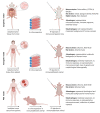Preclinical In Vivo-Models to Investigate HIPEC; Current Methodologies and Challenges
- PMID: 34298644
- PMCID: PMC8303745
- DOI: 10.3390/cancers13143430
Preclinical In Vivo-Models to Investigate HIPEC; Current Methodologies and Challenges
Abstract
Hyperthermic intraperitoneal chemotherapy (HIPEC) is a treatment modality for patients with peritoneal metastasis (PM) of various origins which aims for cure in combination with cytoreductive surgery (CRS). Efficacy of CRS-HIPEC depends on patient selection, tumor type, delivery technique, and treatment parameters such as temperature, carrier solution, type of drug, dosage, volume, and treatment duration. Preclinical research offers a powerful tool to investigate the impact of these parameters and to assist in designing potentially more effective treatment protocols and clinical trials. The different methodologies for peritoneal disease and HIPEC are variable. This study aims to review the objectives, methods, and clinical relevance of in vivo preclinical HIPEC studies found in the literature. In this review, recommendations are provided and possible pitfalls are discussed on the choice of type of animal and tumor model per stratified parameters and study goal. The guidelines presented in this paper can improve the clinical relevance and impact of future in vivo HIPEC experiments.
Keywords: cytoreductive surgery (CRS); hyperthermic intraperitoneal chemotherapy (HIPEC); peritoneal carcinomatosis; peritoneal metastasis.
Conflict of interest statement
The authors declare no conflict of interest.
Figures





References
-
- Desai J.P., Moustarah F. Cancer, Peritoneal Metastasis. StatPearls; Treasure Island, FL, USA: 2020.
-
- Verwaal V.J., Bruin S., Boot H., Van Slooten G., Van Tinteren H. 8-Year Follow-up of Randomized Trial: Cytoreduction and Hyperthermic Intraperitoneal Chemotherapy Versus Systemic Chemotherapy in Patients with Peritoneal Carcinomatosis of Colorectal Cancer. Ann. Surg. Oncol. 2008;15:2426–2432. doi: 10.1245/s10434-008-9966-2. - DOI - PubMed
-
- Elias D., Lefevre J., Chevalier J., Brouquet A., Marchal F., Classe J.-M., Ferron G., Guilloit J.-M., Meeus P., Goéré D., et al. Complete Cytoreductive Surgery Plus Intraperitoneal Chemohyperthermia With Oxaliplatin for Peritoneal Carcinomatosis of Colorectal Origin. J. Clin. Oncol. 2009;27:681–685. doi: 10.1200/JCO.2008.19.7160. - DOI - PubMed
-
- Van Driel W.J., Koole S.N., Sikorska K., Schagen van Leeuwen J.H.S., Schreuder H.W., Hermans R.H., de Hingh I.H., van der Velden J., Arts H.J., Massuger L.F., et al. Hyperthermic Intraperitoneal Chemotherapy in Ovarian Cancer. N. Engl. J. Med. 2018;378:230–240. doi: 10.1056/NEJMoa1708618. - DOI - PubMed
Publication types
Grants and funding
LinkOut - more resources
Full Text Sources

